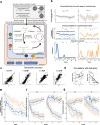Blocking D2/D3 dopamine receptors in male participants increases volatility of beliefs when learning to trust others
- PMID: 37422466
- PMCID: PMC10329681
- DOI: 10.1038/s41467-023-39823-5
Blocking D2/D3 dopamine receptors in male participants increases volatility of beliefs when learning to trust others
Abstract
The ability to learn about other people is crucial for human social functioning. Dopamine has been proposed to regulate the precision of beliefs, but direct behavioural evidence of this is lacking. In this study, we investigate how a high dose of the D2/D3 dopamine receptor antagonist sulpiride impacts learning about other people's prosocial attitudes in a repeated Trust game. Using a Bayesian model of belief updating, we show that in a sample of 76 male participants sulpiride increases the volatility of beliefs, which leads to higher precision weights on prediction errors. This effect is driven by participants with genetically conferred higher dopamine availability (Taq1a polymorphism) and remains even after controlling for working memory performance. Higher precision weights are reflected in higher reciprocal behaviour in the repeated Trust game but not in single-round Trust games. Our data provide evidence that the D2 receptors are pivotal in regulating prediction error-driven belief updating in a social context.
© 2023. The Author(s).
Conflict of interest statement
L.C. has received royalties from Cambridge Cognition Ltd. relating to neurocognitive testing. U.M. discloses consultancy for Janssen-Cilag, Lilly, Heptares and Shire, and educational funding from AstraZeneca, Bristol-Myers Squibb, Janssen-Cilag, Lilly, Lundbeck and Pharmacia-Upjohn. T.W.R. discloses consultancy with Cambridge Cognition Ltd and a research grant with Shionogi Inc. The remaining authors declare no competing interests.
Figures







Similar articles
-
Effects of dopamine D2/D3 receptor antagonism on human planning and spatial working memory.Transl Psychiatry. 2017 Apr 25;7(4):e1107. doi: 10.1038/tp.2017.56. Transl Psychiatry. 2017. PMID: 28440817 Free PMC article.
-
Repeated imipramine treatment enhances the 7-OH-DPAT-induced hyperactivity in rats: the role of dopamine D2 and D3 receptors.Pol J Pharmacol. 2001 Nov-Dec;53(6):571-6. Pol J Pharmacol. 2001. PMID: 11985330
-
Corticosterone and dopamine D2/D3 receptors mediate the motivation for voluntary wheel running in C57BL/6J mice.Behav Brain Res. 2016 Sep 15;311:228-238. doi: 10.1016/j.bbr.2016.05.051. Epub 2016 May 24. Behav Brain Res. 2016. PMID: 27233827
-
Role of dopamine D2 receptors in human reinforcement learning.Neuropsychopharmacology. 2014 Sep;39(10):2366-75. doi: 10.1038/npp.2014.84. Epub 2014 Apr 9. Neuropsychopharmacology. 2014. PMID: 24713613 Free PMC article. Clinical Trial.
-
How dopamine shapes trust beliefs.Prog Neuropsychopharmacol Biol Psychiatry. 2025 Jan 10;136:111206. doi: 10.1016/j.pnpbp.2024.111206. Epub 2024 Nov 23. Prog Neuropsychopharmacol Biol Psychiatry. 2025. PMID: 39586370 Review.
Cited by
-
D2/D3 dopamine supports the precision of mental state inferences and self-relevance of joint social outcomes.Nat Ment Health. 2024;2(5):562-573. doi: 10.1038/s44220-024-00220-6. Epub 2024 Apr 5. Nat Ment Health. 2024. PMID: 38746690 Free PMC article.
-
Disruption of dopamine D2/D3 system function impairs the human ability to understand the mental states of other people.PLoS Biol. 2024 Jun 13;22(6):e3002652. doi: 10.1371/journal.pbio.3002652. eCollection 2024 Jun. PLoS Biol. 2024. PMID: 38870319 Free PMC article. Clinical Trial.
-
Dopamine D2 Receptor Modulates Exercise Related Effect on Cortical Excitation/Inhibition and Motor Skill Acquisition.J Neurosci. 2024 May 8;44(19):e2028232024. doi: 10.1523/JNEUROSCI.2028-23.2024. J Neurosci. 2024. PMID: 38553046 Free PMC article. Clinical Trial.
-
L-DOPA and oxytocin influence the neural correlates of performance monitoring for self and others.Psychopharmacology (Berl). 2024 May;241(5):1079-1092. doi: 10.1007/s00213-024-06541-9. Epub 2024 Jan 29. Psychopharmacology (Berl). 2024. PMID: 38286857 Free PMC article. Clinical Trial.
-
Effects of dopamine D2/3 and opioid receptor antagonism on the trade-off between model-based and model-free behaviour in healthy volunteers.Elife. 2022 Dec 5;11:e79661. doi: 10.7554/eLife.79661. Elife. 2022. PMID: 36468832 Free PMC article.
References
Publication types
MeSH terms
Substances
LinkOut - more resources
Full Text Sources

